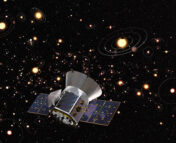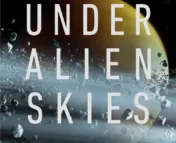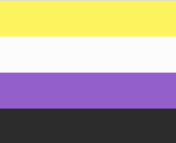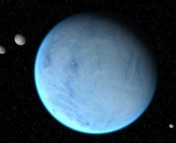Who doesn’t like to think about aliens? There’s a reason humanity has so many stories of visitors from beyond, and why we’re all enthralled by the latest discoveries of Earth-like planets around other stars. It’s the same reason the most common question I’m asked as an astronomer is “Do you believe in aliens?” The possibility of life beyond Earth pokes at fundamental questions, ones that we all hold in common: Are we alone? How did we get here?
In her upcoming book, The Possibility of Life: Science, Imagination, and Our Quest for Kinship in the Cosmos, author Jaime Green takes the time to deeply explore not only these fundamental questions, but the current state of science surrounding them and what they can tell us about ourselves.
The Possibility of Life is a unique new entry into the genre of “astronomy books about aliens.” It manages to keep up with the most recent happenings in astrobiology—which is quite a feat, considering the pace of discovery in that field nowadays—while staying extremely down-to-Earth.
Green moves past the question of “what if there’s life beyond Earth?” and instead focuses on the implications of life beyond Earth, and the many ways we’ve imagined and investigated life beyond Earth. “I’m less interested in the estimations than I am in the possibilities—what might life be like elsewhere, what would that mean for life on Earth?” she writes on pg. 259.
The Life We Know
Rigorously written with a vast selection of expert quotes—from not only astronomers, but journalists, anthropologists, and more—Green has obviously immersed herself in this subject. She explores all the main topics needed for an elementary grounding in the science of astrobiology: the history of life on Earth, how planets form, the exoplanets we’ve discovered, possible biosignatures, the search for extraterrestrial life (SETI), and the musings of astronomers throughout history who pondered these big questions, like Frank Drake and his eponymous equation.
“Scientists work on imagining alien chemistries because we have a plausible need for that knowledge. It just doesn’t make the same sense to spend time thinking about what alien animals might be like. But that doesn’t have to stop you and me,” she writes on pg. 99, giving the reader her permission and encouragement to use their imagination as they read. This book deftly navigates the murky waters between science and speculation, where a significant chunk of alien-related-astronomy currently resides, helping the reader to build their own compass to navigate these terrains in the coming decades of astrobiological discoveries.
The Life We Can Imagine
We, the readers, are lucky to benefit from her tactful synthesis of so much fun astronomical information, explained with wit (“Data is noisy, which is the technical term for a mess,” she writes on pg. 69) and enough Star Trek references to satisfy the most dedicated sci-fi nerds. In fact, it’s not just Star Trek—this book is as much a tour of the tenets of astrobiology as it is a synopsis of decades of human speculation and sci-fi related to aliens.
As a book about humans’ ideas of aliens, it’s also almost more about us than them. For example, Green describes the 1970s project of designing the Voyager probes’ famed golden records, and how the contents were our “chance to project a hopeful, idealized version of humanity. Welcoming, laughing, suffused with love—looking forward, looking outward, and not alone” as she writes on pg. 258. She explores the idea that life may evolve into something technological, what that could mean for us, and what the tech-bros of today insist that means for us. She interrogates the idea of what constitutes an “advanced” civilization, exploring both the canonical Kardashev scale for galactic conquest and other possibilities that account for perspectives beyond that of the white, Western, male capitalist idea of success.
Green does all of this and more with a tenderness that will make you more grateful for the rare blue marble we live on, and more full of awe at the creatures that crawl, fly, buzz, and walk around us on Earth every day. As she says on pg. 19-20, “For all that we imagine, Earth is the only planet we know of with life…Our visions of alien worlds are reflections of ourselves, arising from our research, our dreams, and our subconscious like mist from a field at dawn.”
The Possibility of Life is now available for pre-order, and will be released on April 18th, 2023, available wherever books are sold. (A note from the author of this Bite: support your local indie bookstores!)
Astrobite edited by: Mark Popinchalk
Featured image credit: Justine Sha / Hanover Square Press
Thanks to Jaime Green, Justine Sha, and Hanover Square Press for providing an advance copy of the book for this review!




